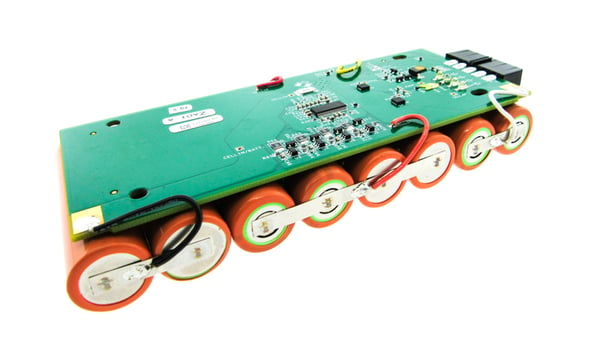Customers who have products or applications using lithium-based batteries understand the risks involved in keeping the battery packs safe during manufacturing processes, when transporting them to specified locations and when they are in use.
Battery management systems (BMS) are required for all lithium-based batteries, and some manufacturers also have them for other battery chemistries. These systems monitor individual cells and have safety features to prevent overcharging, discharging at unsafe levels, and high temperatures. They may also come with other features such as monitoring cell voltage, balancing the cells, and providing readings about the state of health for the battery pack.
Customers have a choice on whether to purchase a customized battery management system or use an off-the-shelf model for applications. There are many factors to take into consideration when using an off-the-shelf system to ensure it works effectively with the battery pack.
Off-the-Shelf vs. Custom
Off-the-shelf battery management systems, also called commercial or standard BMS, are made by a range of manufacturers for both mobile and stationary applications. Electric vehicles, utilities, and back-up power systems are just a few of the products that rely on battery management systems to monitor the health and status of battery cells. For some standard products with simple battery pack needs, you may decide to go with an off-the-shelf battery management system to keep costs low.
On the other hand, custom battery management systems offer a customer more control over the product that will be received. These systems can be designed to work with specific applications and have features that are most desired by the customer. Some custom BMS manufacturers may work from the ground up, while others will take a third-party BMS design and then add features based on the customer's specifications. Due to the customizations, manufacturing prices are higher for custom-built systems.
Unlike custom battery management systems that are designed with the specific features that a customer wants, off-the-shelf systems can come with limitations. You should be aware of these limitations to help you decide whether the system will sufficiently work with the designated battery pack.

Battery pack with integrated management system.
Cell Configurations
There is no one-size-fits-all when it comes to off-the-shelf battery management systems and cell configurations. Many systems are designed to work with specific applications, such as low-voltage batteries, traction packs in electric vehicles, or grid tied and off-grid battery systems. Some off-the-shelf battery systems work with strictly lithium-ion chemistries, while others will work with lithium-ion and lead acid battery packs. There may also only be specific lithium batteries that the off-the-shelf model is designed for, such as mid-voltage 3.3v Lithium-Ion Phosphate (LiFePO4) batteries or 3.6v Lithium Nickel Manganese Cobalt Oxide (LiNiMnCo02) batteries.
Cell configurations also play a major factor. The batteries in the pack may need to be in a certain format, battery size, and array size so that the off-the-shelf battery management system can monitor and balance each cell at an optimal level. Cell forms may include:
- Large prismatic packs
- Small cylindrical packs
- Large cylindrical packs
- Pouches
The number of batteries in the pack can have staggering ranges. Off-the-shelf battery management systems may work with from 2 cells up to 11,000 cells and from 1 bank to 60 banks in a series or parallel. They may also provide monitoring for battery array sizes of 2 batteries up to 60 batteries in a series or parallel.
Feature Limitations
For off-the-shelf battery management system manufacturers, they must compete against each other to appeal to a wide range of applications and industries. Due to these factors, they will load certain features into the battery management system that are desired by either a large base of customers or may specialize the battery features for a specific niche of consumers. However, not every single feature will make the cut. The battery management system may have to be limited in size based on the application, as the size limitation will also limit the number of components that can be placed into the housing.
Most custom and off-the-shelf battery management systems will focus on the main features of battery cell protection, charge/discharge limit monitoring and keeping the battery prepared to power the specific application. However, custom battery management systems may also offer additional features that are not included in off-the-shelf models. These features may include:
- Cell balancing
- Charge control
- State of Health (SOH) readings
- State of Charge (SOC) readings
- Logbook function
Data Packages and BOM
Many custom battery pack manufacturers and BMS designers will offer both the battery pack and BMS system as a set. This package includes the full data package, Gerber data, schematics, and bill of materials (BOM) for the customer so they understand all the functions, features, materials, and component layout inside the BMS system when placed into the application.
Off-the-shelf battery management system manufacturers will not go into such in-depth detail regarding the production process of their products to protect their trademarks. A customer will be provided with a technical manual on how to set up, install, and test the battery management system with the battery pack. The manufacturer will also provide general specifications and detailed specifications regarding the electrical and mechanical aspects of the components.
Testing of BMS
An off-the-shelf battery management system will go through design testing based on the specific cell configurations, battery sizes, and battery formats that the product is made for and advertised to customers. However, the end customer must perform testing once the BMS is installed onto the battery pack. This testing should ensure that the battery management system will shut down the battery pack during charging and discharging. You should also monitor the battery pack and BMS system during the first charge and discharge cycles to ensure proper operation.
Not every off-the-shelf battery management system will have programmed software installed. Some manufacturers provide analog BMS technologies with a fault detector. As technology advances, more off-the-shelf BMS systems with digital displays and built-in programmable software are being made available. The features for these systems may vary, as they can come with a GUI interface, SOC display, dashboard gauges, and status displays.
Some manufacturers of off-the-shelf systems will seek independent testing of their BMS systems. This testing will be performed by organizations such as Underwriters Laboratories (UL) as the manufacturer may include a certificate or the organization's symbol on packaging.
Custom manufacturers perform testing on all battery management systems. They often perform this testing by having the sample battery pack on hand. So, you know that the specific custom BMS will function properly with the batteries that will be used.
Summary
The main advantage of an off-the-shelf battery management system is that they can speed up time-to-market deadlines. You can install and test the system immediately. In addition, the design will be the same for each BMS, ensuring that the quality will be maintained. However, since the design stays the same, off-the-shelf battery management systems cannot adapt and scale to newer cell chemistries and technologies. This problem can make the current design obsolete.
With a custom battery management system, it can keep up with newer components, battery chemistries, and technologies so customers can scale their operations. When your battery pack needs to change, the custom system can be changed to ensure that the battery management system will work with it to promote safe operation.
Key Takeaways
- Off-the-Shelf BMS Offers Faster Time to Market but Less Flexibility: Off-the-shelf battery management systems are ideal for simple applications and offer cost and time advantages. However, they are limited in scalability, customization, and long-term adaptability to evolving battery technologies or unique project needs.
- Custom BMS Solutions Provide Greater Control and Application-Specific Features: Custom BMSs are tailored to the specific requirements of the battery pack and end-use application. They can include features like state-of-charge (SOC), state-of-health (SOH), charge control, and detailed logging, features that are often unavailable or limited in commercial solutions.
- Cell Compatibility and Configuration Must Be Carefully Considered: Off-the-shelf BMSs support a wide range of chemistries and configurations but may not align perfectly with unique cell types or layouts (e.g., pouch, prismatic, cylindrical). Custom solutions allow precise matching of the BMS to the pack’s voltage, capacity, and format.
- Custom BMSs Come with Full Data Packages and BOM Transparency: Custom BMS manufacturers often provide Gerber files, schematics, and full bill of materials for transparency and traceability. Off-the-shelf BMS providers typically do not disclose this level of detail due to intellectual property protections.
- Testing Expectations Differ Significantly Between BMS Types: Off-the-shelf systems require the end user to confirm compatibility and safe operation with their battery packs through in-house testing. In contrast, custom BMSs are usually tested with the actual battery pack by the manufacturer to ensure seamless operation and safety compliance.
















